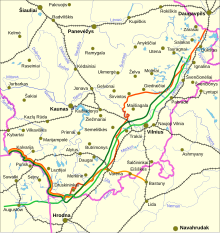Foch Line

The Foch Line was a temporary demarcation line between Poland and Lithuania proposed by the Entente in the aftermath of World War I. The line was proposed by Marshal of France Ferdinand Foch and was accepted by the Conference of Ambassadors in 1919. With small adjustments the line formed the basis of the inter-war Polish-Lithuanian border. The line left Vilnius (Wilno) on the Polish side.[1][2] After World War II only its westernmost part, close to the town of Suwałki, follows the line.
References
- ^ Senn, Alfred Erich (1966). The Great Powers Lithuania and the Vilna Question: 1920-1928. E.J. Brill. p. 20.
- ^ Norman Davies (2011). White Eagle, Red Star: The Polish-Soviet War 1919-20. Random House. p. 57. ISBN 978-1-4464-6686-5.
Bibliography
- Alfonsas Eidintas; Vytautas Tuskenis Zalys; Edvardas Tuskenis (1 October 1999). Lithuania in European Politics: The Years of the First Republic, 1918-1940. Palgrave Macmillan. p. 72. ISBN 978-0-312-22458-5. Retrieved 22 June 2012.
See also
